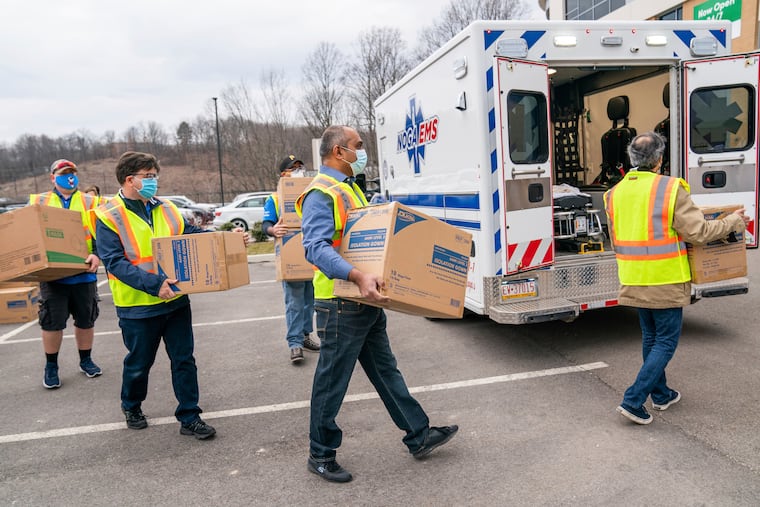COVID-19 is here to stay. Let’s act accordingly. | Opinion
We have to stop treating COVID like an emergency, so that future surges don’t close schools or empty store shelves.

Jan. 20 marks two years since the first confirmed case of COVID-19 in the United States. Almost two years into this pandemic, we are all aching for life to get back to normal. But what is normal now, and how do we get there?
Along with our colleagues, we recently published a series of viewpoints on the need to shift focus from trying to fully eradicate the virus that causes COVID-19 (SARS-CoV-2), a goal that appears increasingly out of reach. Instead, our goals will be to reach a new level of normality, one in which we, with proper measures, find a way to live with a continuous, low-level amount of COVID among us.
Unfortunately, we’re not yet there. A “normal” level of COVID-19 would entail having infections no worse than the worst week in a bad flu season – another virus we have learned how to live with. This could be the equivalent of about 35,000 hospitalizations and 3,000 deaths (<1 death/100,000 population) per week. Currently, COVID is causing roughly 15,000 hospitalizations and 1,900 deaths per day — well past that threshold.
So what can be done to manage COVID-19 and bring life forward to the new normal?
» READ MORE: Philly’s Dr. Ezekiel Emanuel, member of Biden’s COVID task force, lays out how to control the pandemic | Trudy Rubin
We have to start thinking about COVID-19 as a long-term problem and plan accordingly, rather than living in a “perpetual state of emergency,” as we have so far.
It means taking the safety measures that we know work — vaccination, ventilation, air filtration, masking, and testing — and making sure these are widespread and easily accessible for all, with clear guidance on how to use them most effectively.
We have heard a lot about these measures, but it all bears repeating.
First, we need to continue vaccinating as many people as possible. Vaccines have significantly reduced the number of hospitalizations and deaths due to COVID-19. To minimize the effects of COVID-19 on daily life, some estimates suggest that at least 90% of individuals will need some immunity to SARS-CoV-2, whether from vaccination or prior infection. But with only 60% of Americans fully vaccinated, we have a ways to go. But to get to 90% immunity, we don’t want more people to simply catch COVID — that will result in too many preventable deaths. Instead, we have to push vaccines — which will require relying more on vaccine mandates, and develop a better way to verify if someone is vaccinated, such as a digital certificate. (Not these easily forge-able paper vaccine cards.)
Second, we need to improve ventilation and air filtration in buildings, an often-neglected measure despite it being an effective way to prevent transmission of many respiratory diseases, not just COVID. All buildings, including offices, schools, restaurants, and bars, should work to upgrade their air-handling systems to increase intake of outside air and use of efficient filters. Cities should consider giving incentives for upgrades, or modifying their building codes to require all new buildings to include ventilation and filtration upgrades.
“To get to 90% immunity, we don’t want more people to simply catch COVID — that will result in too many preventable deaths.”
Third, while COVID-19 cases are still prevalent in the community, there must be widespread access to high-quality masks, such as N95s or KN95s, which work better than cloth.
Finally, every person in the United States should have access to free or low-cost testing, along with generous paid-leave policies while people are contagious and need to stay home.
It will take a long time to get to 90% population immunity, and that requires us to think and plan ahead. The virus will change over time, and we must be prepared. The United States should invest in its public health systems and systems that monitor how COVID-19 is mutating. This will provide us with appropriate data to understand and properly fight the disease, and a public health workforce that can engage in mitigation efforts.
If we take this long-term approach to fighting COVID-19, we will be less likely to have to pivot at a moment’s notice. In Philadelphia, many schools recently had to switch to virtual learning due to a recent surge of COVID-19 in the community, disrupting student learning, teachers’ plans, and the lives of parents as they scramble to find child care.
In a “new normal,” this type of disruption would be much less likely to occur.
With proper long-term planning in place, even if cases of COVID-19 spike, as flu does in winter months, schools will be prepared. With vaccination of all eligible people, proper ventilation and masking, and a regular testing cadence, students and educators could safely attend school and there would be significantly less community transmission driving disease spread.
For “normal” life to resume without constant COVID-19 disruption, we need to think of the future and prepare for what comes next.
Ezekiel Emanuel is the vice provost for global initiatives at the University of Pennsylvania. Rick Bright heads the Rockefeller Foundation’s Pandemic Prevention Institute. Both authors served on the COVID-19 advisory board for the Biden-Harris transition team.